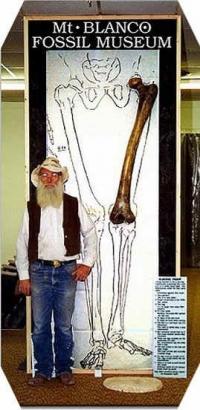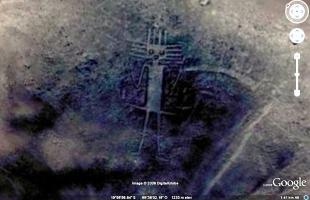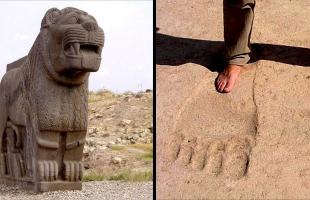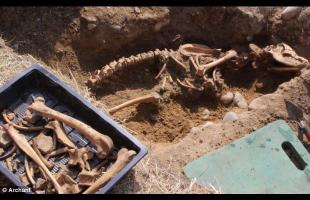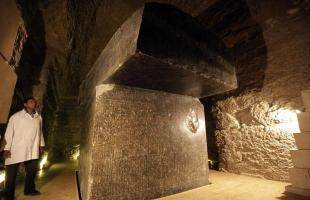The secret of the eighteen giant skeletons of Wisconsin
There are discoveries, which for reasons that are not entirely clear, are archived in the oblivion of human knowledge. Yet, these are findings that could shed light on humanity's remote past, still so shrouded in fog and with many chronological contradictions.

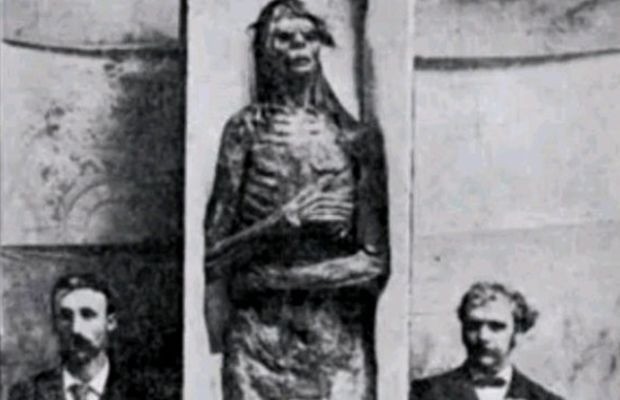
We have already talked about giants in several previous articles, but the story we are telling you seems to add an important element to the theory of those who believe that, in a remote time, a race of giant men inhabited planet Earth.
It is the story of the eighteen giant skeletons of Wisconsin.
It is a curious story that occurred about a century ago, a story which on the one hand would confirm the existence of giants and which, on the other, would corrode the feeling of many, according to which there would be a forbidden archeology in which to archive inconvenient discoveries which could reveal to humanity the true story of its evolution.
In May 1912, a team of archaeologists from Beloit College, in an excavation at Lake Delavan, Wisconsin, uncovered over two hundred effigy mounds that were considered a classic example of the Woodland culture, a prehistoric American culture believed to be dates back to the first millennium BC.
But what amazed the researchers was the discovery of eighteen skeletons of enormous size and with elongated skulls, a discovery that did not fit at all with the classical notions contained in textbooks. The skeletons were truly enormous and, although they had human features, could not belong to normal human beings.
The news had a great echo and caused quite a stir, so much so that the New York Times reported the news in its pages. Perhaps, in those times, there was more freedom and less fear regarding discoveries that could change consolidated scientific beliefs based only on theories.
Thus writes the New York Times columnist in the article published on May 4, 1912:
“The discovery of some human skeletons during the excavation of a hill near Delevan Lake indicates that a hitherto unknown race of men once inhabited Southern Wisconsin. […]. The heads, presumably of males, are much larger than those of Americans today.The skull appears to lean back immediately above the eye sockets, and the nasal bones protrude far above the cheekbones. The jaws appear to be long and pointed […].”
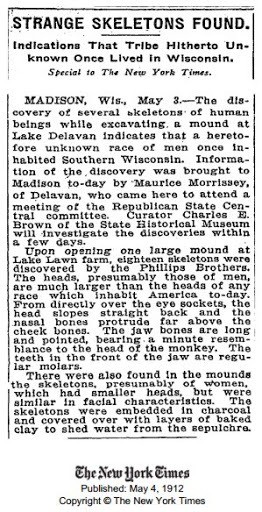
The description of the skulls provided by the New York Times closely resembles the shape of those belonging to skeletons recently discovered in an ancient burial in Mexico [Mass alien burial?], with the difference that here we are dealing with individuals more than three meters tall. Who were they, and why is there no trace in the official chronology that they taught us at school?
Are these giant humans who lived on our planet, and in any case belong to the human race? Could this be an ancient settlement of Ancient Humans, survivors of the tragedy of Atlantis?
Or, are they beings from other worlds, a discovery that would corrode the Ancient Astronaut Theory? Hard to say.
150 years of discoveries
Incredible as it may be, the giant skeletons of Lake Delevan were nothing new in the American archaeological landscape. Digging into local newspaper articles, it turns out that the Wisconsin discovery is just one of dozens and dozens of similar discoveries reported by local newspapers. The first archive news dates back to 1856, reported in an article dated November 21st in the New York Times itself:
“A couple of days ago, some workers discovered a human skeleton underground in Sheriff Wickan's vineyard in East Wheeling, Ohio. Somewhat damaged, it was difficult to identify from the position of the bones, which appear not to have the length of the normal human body in its original position. What impressed the sheriff and the workers was the size of the skeleton, equal to approximately eleven feet (three meters and thirty)! Its jaw and teeth are almost as large as those of a horse".
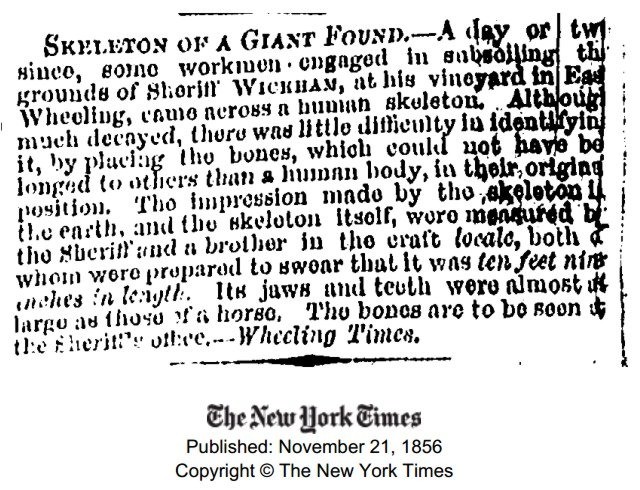
12 years later, in 1868, on Christmas Day, it is still the NYT that gives another news story about giants. Some workers from the Sank Rapid Water Power company were engaged in excavations for the construction of a dam to create hydroelectric energy along the Mississippi River. During the works, the workers found the remains of a gigantic human skeleton embedded in the granite rock:
“The tomb was about six meters long, four feet wide and almost one meter deep. The remains of the gigantic man are completely petrified. The enormous head measures 78 centimeters in circumference, but with a very low forehead and very backward slope. The overall height of the mysterious individual is approximately three meters and forty centimeters."
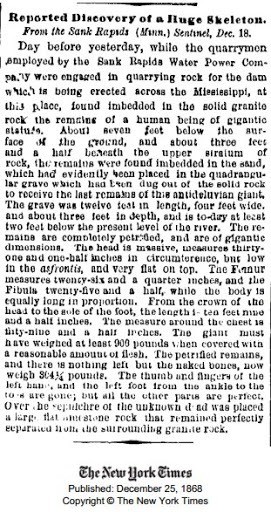
On September 8, 1871, the NYT reported the news of other giant skeletons found during excavation work in Petersburg, Virginia:
“Workers working on the railroad came across a burial site containing the skeletons of what are thought to be Native Americans from a remote era and a lost and forgotten human race. The bodies examined present a very strange and impressive formation. […]. The femur is much longer than that of normal human individuals, so much so that a stature of almost three meters is assumed."
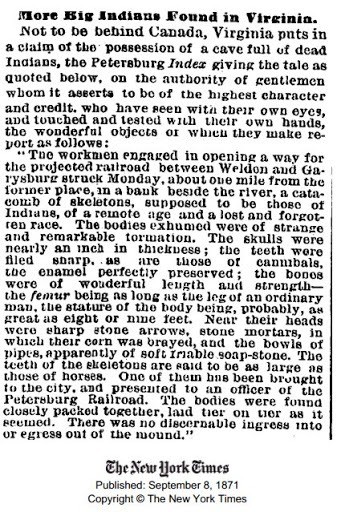
On August 10, 1880, the NYT responded to an article reported by the Harrisburg Telegraph, which reported an excerpt from a report drawn up on May 24, 1798 by Judge Atlee following a strange discovery:
“In the company of Chief Prosecutor McKean, Judge Bryan, Mr. Burd and other respectable gentlemen, we went to Mr. Burd's property, where we were shown the place near his home where two human skeletons were found several years ago. The skeletons measure approximately three meters and thirty”.
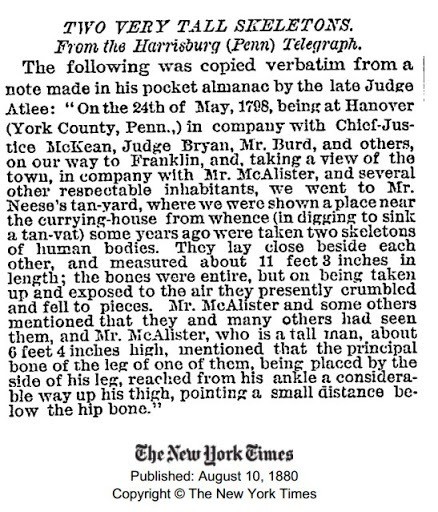
On May 25, 1882, the NYT reported the news of a discovery near St. Paul, Minnesota:
“A skeleton of heroic dimensions and a singular shape was discovered during excavation work on a hill in the Red River Valley. [….]. The skeleton in question was in a perfect state of preservation. The man was identified as a "giant". An investigation of the excavation and its contents has been initiated by the Historical Society”.
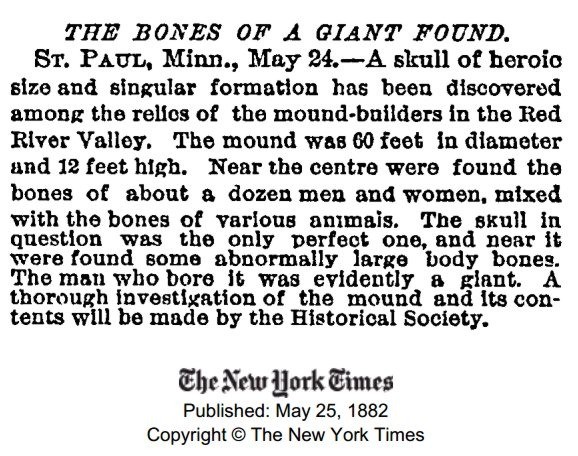
On December 20, 1897, the NYT reported the first discovery of giants in Wisconsin, near Maple Creek. Three burial hills were discovered, one of which was opened to reveal its mysterious contents: the skeleton of a gigantic man. The height of the being was almost three meters, and its state of conservation was almost perfect.
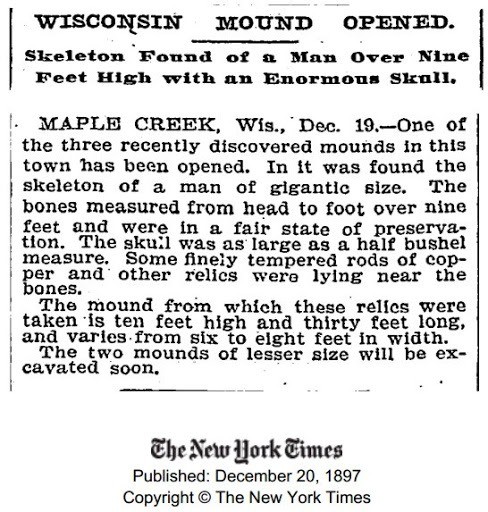
On February 11, 1902, news was reported of an archaeological expedition to a site in New Mexico, where some gigantic human skeletons were found:
“After the discovery of remains of a race of giants in Guadalupe, New Mexico, archaeologists prepare for an expedition to the region […]. Luciana Quintana, the owner of the ranch where the ancient bones are located, discovered two stones with curious inscriptions. Digging beneath them, the bones of skeletons belonging to individuals no less than three meters and sixty tall were discovered [...].Quintana, who later discovered many other similar sites, believes that there are thousands of buried skeletons of a lost race of giants. The assumption is based on a tradition that began with the first Spanish invasions, according to which a once remote ancient race of giants inhabited the region now known as eastern New Mexico. The legends of the American Indians tell the same tradition”.
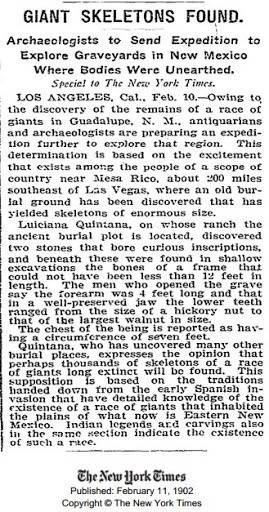
But the New York Times is not the only newspaper to cover giants. Even some newspapers from the beginning of the century reported news of giants, such as the Sun of 1893, New Age Magazine of 1913, Popular Sciences of 1932, the San Antonio Express of 1940.
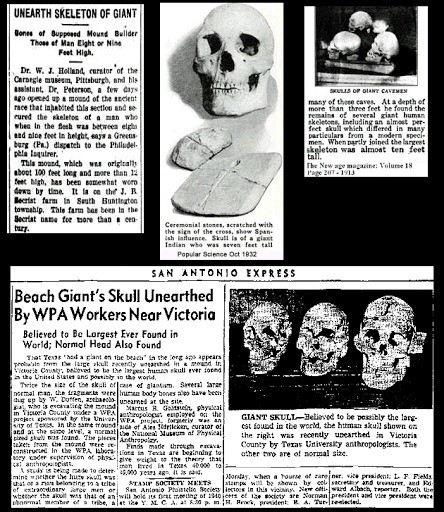
James Vieira, an independent researcher, for almost twenty years, and before the advent of the internet, collected thousands of journalistic references on the findings of the giants, digging into the archives of the New York Times, the Smithsonian Ethnology Reports, the American Antiquarian and Scientific American, discovering that a large part of these discoveries is practically hidden from the general public.
Among Vieira's notable discoveries is a photo found in the Smithsonian Ethnology Reports archives, taken during a lecture by Prof. McGee (in the photo on the left), in which we see a giant skeleton measuring around six feet tall, later sold to the Smithsonian Institution for the sum of $500.
The skeleton appears to belong to the so-called Mound Builders culture, an ancient population of North America who lived about 5 thousand years ago, in a period preceding the history of Ancient Egypt and all its dynasties.
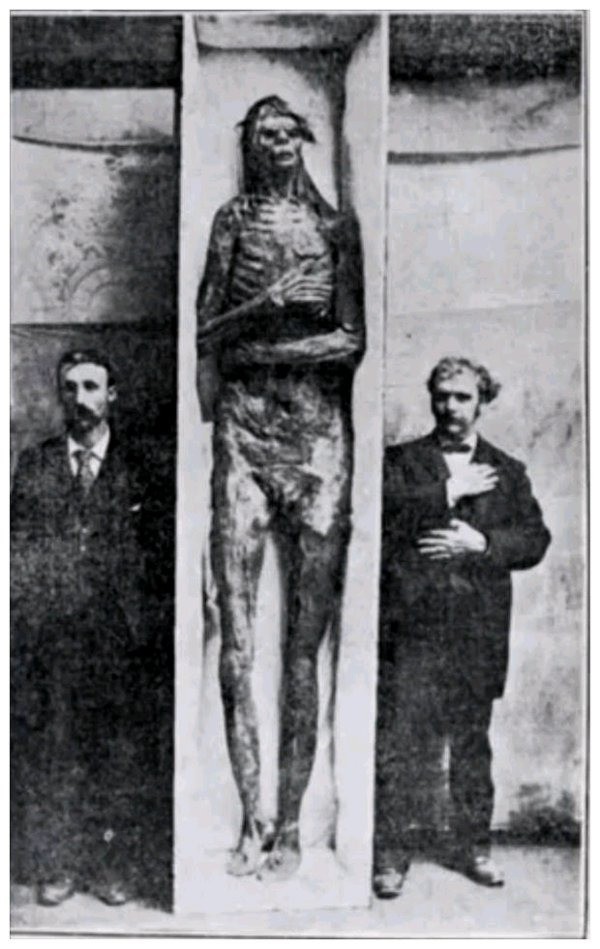
According to conspiracy theorists, the Smithsonian Institution purchased the skeleton with the desire to remove it from public knowledge. But why? Why would there be a giant cover-up of all these discoveries? And why have these exciting and enigmatic finds ever been exhibited in any museum in the world?
According to Vieira, the motivation would be very simple: the need to keep Darwin's Theory of Evolution valid, which explains very well the normal evolutionary path of all living beings, including humans, from simple to more complex forms.
The problem is that these skeletons, as far as human beings are concerned, would instead seem to show an involution, as the complexity of the gigantic fossils found is particularly evident. How to place these giant humans on the evolutionary scale of man? But can this motivation be enough to eliminate finds that could shed light on man's distant past?
According to Ancient Human theorists, the inhabitants of the mythical Atlantis were the famous giants also mentioned in the Bible. Some survivors of the destruction of the ancient Atlantean civilization would later lay the foundations for the creation of our species and our civilization. Maybe this is the story they want to keep hidden? And why? Why could the catastrophic event that destroyed Atlantis destroy us too, sooner or later?
Ultimately, there are those who hypothesize that the giant skeletons do not belong to the human species but are the bodies of Ancient Astronauts who once inhabited our planet. In this sense, the cover-up could be traced back to the broader strategy that seeks to hide the existence of extraterrestrials from humanity. In any case, that of giants, like that of Atlantis, for one reason or another, remains a taboo subject for the scientific community.









